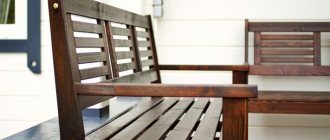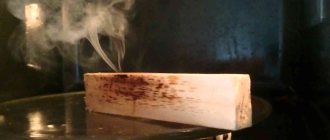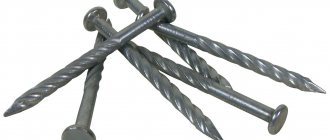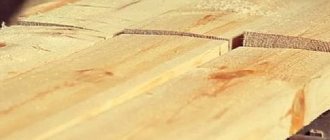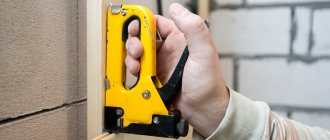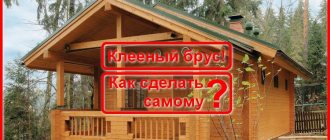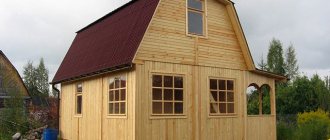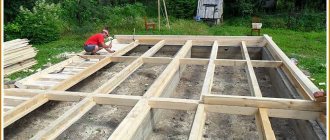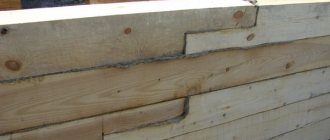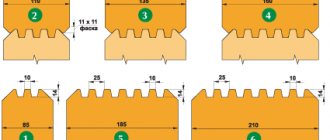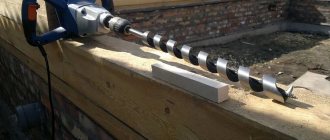Types of timber for building a house: regular, dry, glued and warm timber
Wood for the construction of turnkey log houses has completely different characteristics. Manufacturers offer timber with natural humidity and chamber drying, solid and glued, models with a flat and round surface, teeth, Finnish and German “comb”. What to build a house from? Let's look at what types of timber there are in more detail.
Classification of laminated veneer lumber by profile types
The horizontal plane of the part remains flat or is given a special shape for connecting the crowns. Profile section options that are used in most log house projects:
- Flat or with beveled chamfers. Suitable for assembling light buildings. Additional interventional insulation is required;
- With one or two tongues and grooves. The parts are fixed into each other;
- Finnish profile. Between the spikes there is space for hidden insulation. Some models provide for the installation of insulating cords in grooves;
- “Comb” (German profile). The horizontal surface is made in the form of teeth that prevent the passage of air. Inter-crown insulation is not required.
The German “Comb” profile
is more expensive to manufacture - high production precision is required. But if the technology is followed, the result is a proper log house with strong walls that do not need additional insulation.
What kind of timber is there in terms of humidity level?
Natural moisture timber
This is the cheapest option - the wood is delivered to the construction site immediately after processing. A beam of natural moisture can be smooth or profiled, but after shrinkage, cracks and crevices still appear in it.
All types of timber houses undergo a shrinkage process, but wood with natural moisture deforms more than others. The material behaves unpredictably: it bends, twists, cracks, shrinks unevenly, and changes linear size. The owner will have to seal the gaps, cracks, insulate the walls and begin the final design no earlier than a year after assembly.
Chamber drying timber
The material is brought to the required humidity (usually 8-14%) in special drying chambers, then processed and collected in a dry state. The shrinkage of such wood is close to the parameters of laminated veneer lumber, unless the wood gets wet during construction.
The main problem with chamber drying of timber with a thickness of more than 100 mm is cracks. To preserve the surface, it is necessary to increase the time spent in the chamber. Standard processing of thin wood is 10-12 days. High-quality drying of 150-200 mm timber lasts up to several weeks and even months. Attempts to increase the temperature and speed up the process lead to uneven drying - the wet center breaks the dry outer part.
Additional drying time and a large number of rejects (some parts crack) increase the cost of the material. The wood needs to be protected from moisture until it is covered, but the walls are deformed much less and repairs are not required after shrinkage. If you choose solid timber, then chamber drying is much better than material with natural moisture. It is from chamber-drying boards that high-quality laminated veneer lumber is produced.
| Natural humidity | Chamber drying | |
| Shrinkage time | Intensive - 3-4 months Gradual - up to 12 months | Up to 3 months |
| Shrinkage percentage | 8-12 % | Up to 3-4% |
In practice, manufacturers often use “dried” timber, that is, the material spends the required 10 days in the chamber in normal mode. The result is a workpiece with a dry surface and a wet core, which can be processed well on machines. Such wooden log houses quickly take a permanent shape, but there is no protection against deformation and cracks.
Material for making timber
Pine
The most affordable type of wood. When using pine, it is important to organize full incoming and production control - the lumber can contain defects in the form of resin pockets, chips, cracks, and parasite damage.
Spruce
Spruce must be checked for knots and cracks. The tree has a special smell and does not release resin as intensely in its natural form. Many customers prefer laminated veneer lumber from spruce.
Exotic and combined materials
Along with pine and spruce, cedar or larch timber can be used, but the cost increases significantly. In addition, larch is a denser material, which means it is heavier, which complicates the assembly process. Also, larch has higher thermal conductivity, which means worse thermal insulation properties.
Correct combination of materials
It is possible to use a backing board or make a lower crown from larch. The breed is less susceptible to rotting than others, tolerates moisture well and protects the rest of the log house from damage.
Incorrect combination of materials
Sometimes manufacturers offer combined laminated veneer lumber: the middle is made of pine or spruce, and the top is made of more expensive material. Such gluing is unreliable: different types of wood differ in temperature deformations and react to changes in humidity.
Features of individual stages of construction
Before you start building a house from profiled timber, you need to familiarize yourself with the features of its individual stages. First, pre-treatment is performed - the wood must be treated with an antiseptic . Antiseptic agents protect the material from rotting and mold.
House made of profiled timber under construction Source drevdom.ru
Regular, warm and laminated timber
The main difference between the materials is the structure of the beam
- Ordinary timber. Produced from solid logs by planing. Minimal processing preserves the natural structure of the tree with all its advantages and disadvantages.
- Double heat beam. It consists of three separate parts: two boards (inner and outer) and a layer of insulation. The design is similar to a sandwich panel with a wooden base. In some designs, the parts look like a full-fledged profiled beam with insulation in the middle; in others, a double frame is assembled into which thermal insulation is placed.
- Glued laminated timber. The part is glued together from pre-dried and treated lamellas. With the correct selection of wall thickness, durable and warm timber houses are obtained. If the technology is followed, a high-strength part is produced from 5, 7 or more boards.
| Regular timber | Double heat beam | Glued laminated timber | |
| Price | Cheaper than others due to minimal processing. | The price is average: built-in thermal insulation is more expensive than solid wood, but cheaper than laminated wood. | The material is expensive (at the initial stage): complex manufacturing technology. |
| Appearance | After shrinkage, cracks and crevices appear, which are visible even after caulking. The look is more “rustic” than prestigious and modern. | Thin boards may crack and warp, but overall the wall looks neat. | Subject to regular treatment (coating every 5-7 years) it practically does not change over the years. |
| Construction period | After assembly, it takes time to shrink. The pause depends on the degree of humidity, but not less than 12 months. | Laying double boards is more difficult, there is a possibility of damaging the thermal insulation, so high-quality assembly takes longer. | Classic styling using proven technology and minimal shrinkage. Installation is accelerated, you can immediately begin finishing. |
| Thermal insulation | Low. Cracks and crevices, even after sealing, become points of heat loss. | High. A layer of thermal insulation reliably retains heat (until cracks appear in the outer boards). | High. The material is not deformed, there are no through cracks. |
| Reliability and durability | Average. If the assembly technology, a pause for shrinkage, and high-quality finishing are followed, the house can be used for 30-50 years. | Average. Boards have less strength, crack more often, and deteriorate faster. Regular inspections, treatment, and restoration of the thermal insulation layer are required. | High (for a material that is produced strictly according to technology). Lamels made of dry boards “grow together” and keep adjacent parts from deformation and cracking. |
| Environmental friendliness | Natural material. The main condition is to choose a safe coating, an antiseptic. | Depends on wood processing and filler type. | Depends on adherence to technology. The main requirement is high-quality glue for connecting the lamellas. |
Important distinctive characteristics of timber from Finland
Finnish style cottage project
Finnish timber is one of the selected materials for construction, since its price is quite high. But almost everyone can afford to build a small sauna or steam room from Finnish wood.
What makes the timber from Finland stand out?
- The arcs of the rings of the glued planks are directed toward the center, and the core is directed outward. This arrangement of wood fibers guarantees durability and increased strength due to reduced stress inside the bar; (See also the note How to choose a block: selection by indicators.)
Placement of rings in glued lamellas per year
- Different types of coniferous trees do not mix, which guarantees a beautiful and uniform tone;
- The gluing strength is ensured by splicing in a vertical position after four to six meters, but a maximum of three meters. As you can see in the photo, this gluing technology guarantees a beautiful appearance and an almost invisible seam;
- According to Finnish technology, only wide slats are used. This is due to the fact that the adhesive base impregnates the wood by one and a half to two centimeters. And therefore, thin lamellas are almost completely saturated with glue and lose their ability to “breathe”. The Finnish block, 200 millimeters thick, is made of three spliced lamellas with adhesive impregnation of no more than eight millimeters. This makes it possible to completely preserve all the positive technical characteristics of real wood.
It must be said that a good quality imitation of Finnish timber is almost similar in technical and aesthetic characteristics to its analogue, but the price of such material is much less.
Winter bars at the ends are a couple of tones brighter
Advice. When purchasing material for wood construction, give preference to timber made from winter wood. It is drier and stronger. A characteristic feature of winter wood is the brighter coloring of the ends and the absence of fiber on the longitudinal cuts. Experts recommend controlling the material using the following option. Drop iodine onto the cut of the block - if the stain turns blue, it means there is a lot of starch in the tree, and this is a characteristic feature of “winter” lumber.
So which timber is better? conclusions
By all indications it is clear that a high-quality timber should be:
- Profiled. Moreover, it is advisable to make the profile in the form of a comb - this way you can do without insulation and ensure reliable engagement of the crowns;
- Glued. Characteristics and properties of laminated veneer lumber: minimal shrinkage, reduced construction time and absence of deformation, which gives advantages over conventional timber. Compared to thermal timber, laminated laminated material benefits due to the reliability of the walls;
- Sufficient thickness. A difference of 1-2 cm significantly affects strength, heat and sound insulation. For year-round living in central Russia, the best option is a wooden wall with a thickness of 200 mm or more.
The main disadvantage of laminated timber is the price at the initial stage. But after 2-3 years of use, costs level out due to minimal maintenance, savings on finishing and insulation.
House made of laminated timber GOOD WOOD according to project SP-4
Side processing
The side of the laminated timber is processed, creating either a flat or semicircular surface. The semicircular shape gives the wall timber the appearance of solid logs and is often used for laying the outside of a building. The inner surface of the walls is usually left flat.
- Profile “Standard Duo” Holz House.
